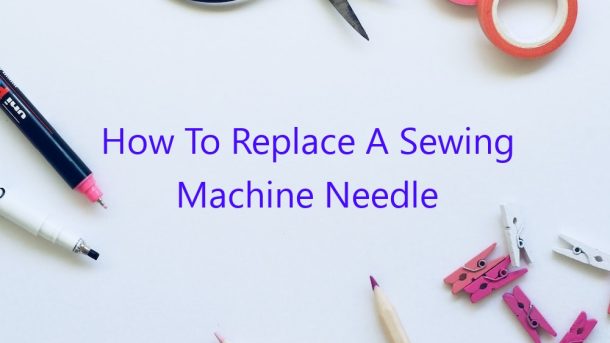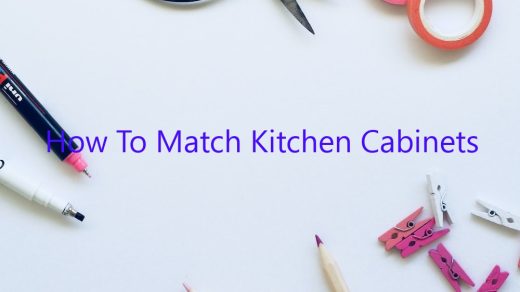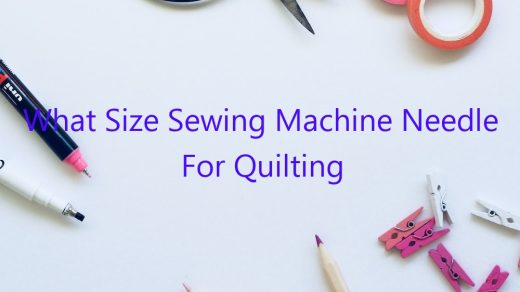A sewing machine needle is a small, pointed piece of metal that is used to sew fabric together. Over time, the needle can become dull and blunt, which can make it difficult to sew fabric together. If the needle becomes too dull, it can also damage the fabric.
If your sewing machine needle needs to be replaced, here is how you can do it:
1. Begin by unthreading the machine.
2. Next, remove the needle clamp screw and needle clamp.
3. Now, you can remove the old needle.
4. Insert the new needle into the needle clamp.
5. Replace the needle clamp screw and needle clamp.
6. Thread the machine.
7. Test the machine to make sure it is sewing correctly.
Contents
How do you change the needle on a Singer sewing machine?
Singer sewing machines have been around for more than 150 years, and are still a popular choice for sewing enthusiasts today. One of the main reasons for their enduring popularity is their ease of use – and one of the main reasons for this ease of use is their user-friendly design.
One of the most user-friendly features of Singer sewing machines is the way in which the needle can be easily replaced. In this article, we will show you how to change the needle on a Singer sewing machine.
First, make sure that the machine is turned off and unplugged. Then, open the bobbin cover and remove the bobbin.
Next, locate the needle clamp screw at the front of the machine and loosen it.
Now, use your fingers to hold the needle while you unscrew the needle clamp with your other hand.
Once the needle clamp has been removed, you can pull the old needle out of the machine.
Then, insert the new needle into the machine and screw on the needle clamp. Make sure that the needle is inserted in the correct direction, with the flat side of the needle facing the back of the machine.
Finally, re-insert the bobbin and close the bobbin cover. The machine is now ready to be used.
How do you replace a broken needle?
Replacing a broken needle on a sewing machine can seem daunting, but with a little bit of patience and a few simple tools, it can be done in just a few minutes.
The first thing you’ll need is a new needle. Make sure the size and type of needle are the same as the one you’re replacing. You’ll also need a small screwdriver, a pair of pliers, and a needle threader.
The first step is to remove the old needle. Use the screwdriver to remove the screw that holds the needle in place. Be careful not to lose the screw, as it will need to be re-inserted later.
Next, use the pliers to grip the old needle and pull it straight out. If the needle is stubborn and doesn’t want to come out, you can use the needle threader to help. Just insert the threader into the tiny hole at the top of the needle and use the pliers to pull it out.
Now it’s time to install the new needle. The screw that holds the needle in place is usually very tight, so you’ll need the screwdriver to get it started. Once the screw is started, you can use the pliers to tighten it up.
Make sure the new needle is straight before you tighten the screw too much. If it’s not straight, the machine will not sew properly.
Once the screw is tight, re-install the screw cover and you’re done.
Are sewing machine needles universal?
Are sewing machine needles universal?
This is a question that many people have wondered about, and the answer is actually a bit complicated. Sewing machine needles come in a variety of sizes, and each size is designed for a specific type of fabric. There are, however, some needles that are designed to be universal, meaning that they can be used with a variety of fabrics.
The most common type of sewing machine needle is the sharp needle. This type of needle is designed for light- to medium-weight fabrics, such as cotton, linen, and silk. The sharp needle has a small, sharp point that is ideal for piercing fabric.
The next most common type of sewing machine needle is the ballpoint needle. This type of needle is designed for use with heavy-weight fabrics, such as denim and corduroy. The ballpoint needle has a blunt point that is designed to push the fabric fibers aside instead of piercing them. This prevents the fabric from being damaged and makes it less likely to snag.
There are also a variety of specialized needles available, such as needles for quilting and needles for embroidery. These needles are designed for use with specific types of fabrics and should not be used with other types of fabrics.
So, are sewing machine needles universal? In a word, no. Each type of needle is designed for a specific type of fabric. However, there are a few needles that are designed to be universal, meaning that they can be used with a variety of fabrics.
How do I know if my sewing machine needs a new needle?
When it comes to sewing machines, needles are a key component. If the needle is dull or damaged, it can affect the quality of your stitches. So, how do you know if your sewing machine needs a new needle?
There are a few things to look for. If the needle is bent, chipped, or rusty, it’s time to replace it. You should also pay attention to the stitch quality. If the stitches are looking messy or uneven, the needle might be the culprit.
If you’re not sure if it’s time for a new needle, it’s always a good idea to consult your machine’s manual. Most manuals will have a guide for changing the needle, and it’s a good idea to follow the manufacturer’s instructions.
Needles are a small part of your sewing machine, but they play an important role in the quality of your stitches. So, if you’re noticing any problems with your stitching, it might be time for a new needle.
Do singer needles fit all machines?
Do Singer needles fit all machines? Singer needles are designed to fit Singer machines, but may fit other machines. Some machines, such as the Brother Innov-is 950D, use a type of needle called a “style U” needle. Singer needles are not style U needles, so they will not fit the Brother Innov-is 950D. Singer also makes a type of needle called a “style 100” needle. This type of needle is larger than a style U needle, so it will not fit the Brother Innov-is 950D. Singer also makes a type of needle called a “style 14” needle. This type of needle is smaller than a style U needle, so it will fit the Brother Innov-is 950D. Singer needles come in different sizes, so it is important to know the size of the needle you need before you purchase a Singer needle.
Which way does flat side of needle go?
When you’re knitting, the long, thin needles you use have a pointed end and a flat side. The pointed end is used to insert the needle into the fabric, while the flat side is used to hold the knitting in place. The question of which side of the needle should be facing up is a common one, and there is no one right answer.
Some knitters prefer to have the flat side of the needle facing up, as it provides a more stable surface for the knitting to rest on. This can help to prevent the knitting from slipping off the needles, which can cause dropped stitches.
Others prefer to have the pointed end of the needle facing up, as it makes it easier to insert the needle into the fabric. This can be helpful for beginners, as it can be more difficult to navigate the needles around the stitches if the flat side is facing up.
In the end, it’s up to you to decide which side of the needle you prefer. Just make sure to be consistent, so that your knitting looks neat and tidy.
How do you put in a sewing needle?
There are a few different ways to put in a sewing needle. One way is to thread the needle. You can do this by putting the thread through the eye of the needle. Another way is to use a needle threader. This is a small tool that helps you to thread the needle. You put the thread through the hole in the needle threader and then the needle threader through the eye of the needle. Then you pull the thread through.
Another way to put in a sewing needle is to use a needle holder. This is a small tool that helps you to hold the needle. You put the needle in the hole in the needle holder and then the needle holder in your hand. This makes it easier to hold the needle.
The last way to put in a sewing needle is to use a magnet. You can buy a magnet that is made for sewing needles. You put the magnet on the end of the thread. Then you put the needle on the magnet. The magnet will hold the needle in place.




